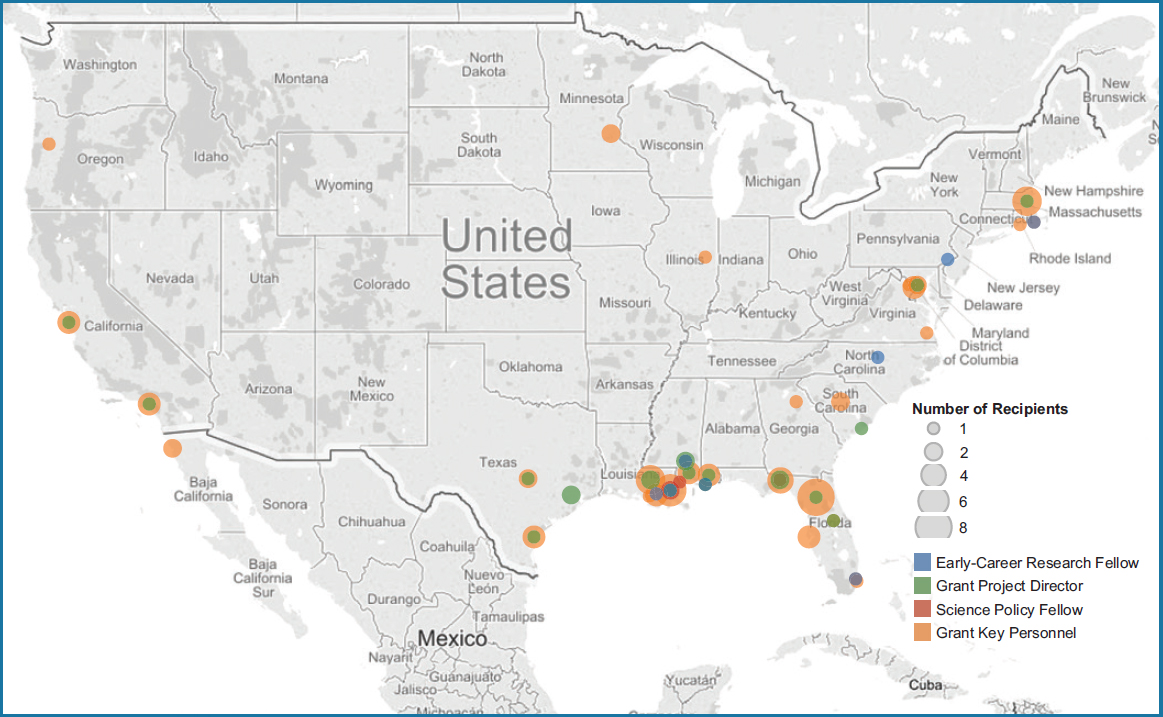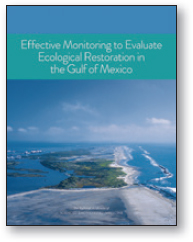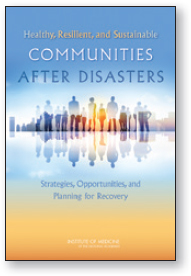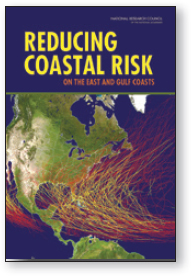2015 Investments
SCIENTIFIC LEADERSHIP AND CAPACITY BUILDING
In September 2015, the GRP’s two new fellowship programs—Science Policy Fellowships and Early-Career Research Fellowships—welcomed their first cohorts of fellows at an orientation in New Orleans, Louisiana. The talented group of scientists selected for these fellowships reflects the GRP’s commitment to supporting the development of future generations of scientists, engineers, and health professionals prepared to work at the intersections of oil system safety, human health and well-being, and environmental resources. Four Science Policy Fellows and eight Early-Career Research Fellows received a total of $818,000 of funding in stipends and research monies, for 1 year (Policy Fellows) or 2 years (Research Fellows).
Science Policy Fellowships
Science Policy Fellows spend 1 year on the staff of a state environmental, natural resources, oil and gas, or public health agency, or in regional offices of relevant federal agencies in the Gulf region. These fellowships provide an immersive policy experience for early-career scientists, by which they gain first-hand knowledge of the regulatory and policy-making organizations that work to address challenges particular to coastal regions. Additional funds (up to $5,000 per fellow) are available for professional development activities and travel.
In 2015, fellows were placed in host offices at the Florida Department of Environmental Protection; the Gulf of Mexico Office of the Bureau of Ocean Energy Management (BOEM); the National Oceanic and Atmospheric Administration (NOAA) Resources and Ecosystems Sustainability, Tourist Opportunities, and Revived Economies of the Gulf Coast States Act (RESTORE Act) Science Program; and the Gulf Coast Ecosystem Restoration Council (RESTORE Council). According to the GRP’s first cohort of fellows and host offices, this fellowship is a mutually beneficial experience; the fellows gained significant experience working at the science–policy interface, while also bringing valuable new perspectives to their host offices. See 2015 Science Policy Fellows to learn more about the fellows and their experiences.
Early-Career Research Fellowships
The GRP offers Early-Career Research Fellowships for assistant professors (or equivalent) at colleges, universities, and research institutions to recognize professionals at the critical pre-tenure phase of their careers for exceptional leadership, past performance, and potential for future contributions to improving oil system safety, human health and well-being, or environmental protection.
In 2015, eight individuals—five from Gulf institutions and three located elsewhere across the nation working on Gulf-relevant topics—received the GRP’s first Early-Career Research Fellowships. These fellows have wide-ranging expertise that spans chemical engineering, public health, and coastal geology. The 2 years of funding and mentorship provided by the fellowship program allows researchers to pilot new and potentially risky research, broaden the disciplinary scope of their work, support trainees, and travel to build networks with new collaborators. See 2015 Early-Career Research Fellows to learn more about the GRP’s first Early-Career Research Fellows and how GRP support is affecting their research.
SCIENCE TO ADVANCE UNDERSTANDING AND SERVE COMMUNITY NEEDS
In 2015, the GRP opened competitions for its first two research grant opportunities: Exploratory Grants and Synthesis Grants to spark innovative and cross-disciplinary research on topics identified in the GRP’s 2014 opportunity analysis workshops. After a rigorous peer-review process, 21 projects were selected to receive GRP funding totaling $5.9 million for award year 2015 grants.
Exploratory Grants
2015 Exploratory Grants were made for two themes: (1) how to effectively educate and train offshore oil and gas and health professionals, and (2) how to improve understanding of links between human well-being and ecosystem services related to oil and gas production. Twelve projects—with personnel from 15 institutions in the Gulf states and 9 from elsewhere in the United States—received a total of $1.5 million of grant funds.
Exploratory grants are intended to catalyze innovative thinking by providing seed money to advance research in its early conceptual phase, accelerate progress from concept to testing, and foster the development of novel approaches. The Summary of Grantees lists grantee projects, which span research on virtual offshore disaster training, environmental health leadership development, and management decision support tools.
Synthesis Grants
2015 Synthesis Grants were made for two themes: (1) to use existing monitoring data to inform efforts to restore and maintain the Gulf of Mexico’s ecosystem services, and (2) to enhance understanding of

the Deep Gulf or its physical and biological connectivity to coastal communities. Nine research teams, bringing together expertise from 20 institutions from across the nation, received a total of $4.4 million of grant funds.
Synthesis grants seek to extend the usefulness of existing monitoring data by encouraging applicants to synthesize and integrate data derived from different sources or collected for different purposes to obtain novel insights or to increase the applicability of scientific research. The Summary of Grantees lists grantee projects, which include integration of visual and acoustic data to develop cetacean habitat models, using medical claims and other data to conduct large-scale evaluations of disaster effects, and combining historical observation data with contemporary models to understand circulation in the Deep Gulf.
Planning for Award Year 2016 Grants
To complement the RFA opportunities offered in 2015, the GRP developed new topics for a second round of Exploratory and Synthesis Grant competitions in 2016. These topics emphasize community resilience, protecting human health and well-being, and the role of human and organizational factors for creating a culture of safety in offshore oil and gas operations. The GRP also created a third grant type—Capacity-Building Grants—for community-focused organizations. The 2015 and 2016 topics reflect the GRP’s broad mission to enhance oil system safety and the protection of human health and the environment (see 2015 and 2016 Grant Topics below).
As the program develops, our portfolio of funding opportunities and activities will continue to evolve and span the social, health, environmental, and physical sciences, and offer new opportunities that seek to engage the variety of perspectives—including research, governmental, industry, and community organizations—needed to address complex, cross-boundary challenges.
Activities at the National Academies of Sciences, Engineering, and Medicine
The GRP also supports projects that take advantage of the consensus-building and convening power of the National Academies of Sciences, Engineering, and Medicine. In 2015, the GRP funded one consensus report and two report dissemination activities relevant to the Gulf region.

Report on Effective Monitoring to Evaluate Ecological Restoration in the Gulf of Mexico: In 2015, an Academies’ study committee convened by the Division on Earth and Life Studies’ Ocean Studies Board and Water Science and Technology Board began its work to develop a report that will provide guidance on effective approaches for monitoring and assessing Gulf restoration. The study concept was developed with help from other Deepwater Horizon–related funders and agencies, including the National Fish and Wildlife Foundation; the RESTORE Council; NOAA; and a number of other federal and state agencies with restoration responsibilities. The report was released in July 2016.

Community Discussion Toolkit for Health in Post-Disaster Recovery Planning: The GRP provided funds to the Board on Health Sciences Policy to partner with a Gulf Region community to conduct a pilot test of a discussion toolkit designed to help communities identify and implement recovery planning and strategies that optimize community health. The toolkit is based on the 2015 report Healthy, Resilient, and Sustainable Communities After Disasters: Strategies, Opportunities, and Planning for Recovery. The pilot will take place in September 2016.

Planning Meeting for a Community Engagement Activity About Coastal Risk Reduction: The GRP provided funds to the Academies’ Koshland Science Museum, the Water Science and Technology Board, and the Ocean Studies Board to follow up on the 2014 report Reducing Coastal Risk on the East and Gulf Coasts. The museum and boards convened a planning meeting to discuss a tool for engaging communities in decision making about the challenges of and solutions for responsible coastal development. Coastal risk experts from the Gulf region and beyond met to outline a framework for an interactive tool that could be used by communities and decision makers.







